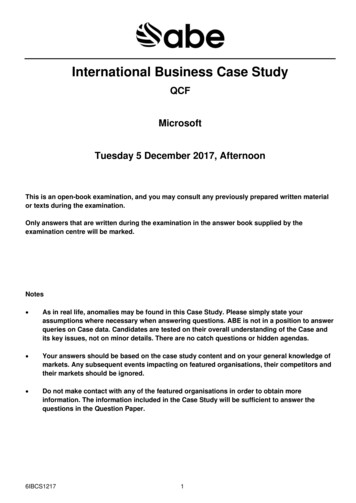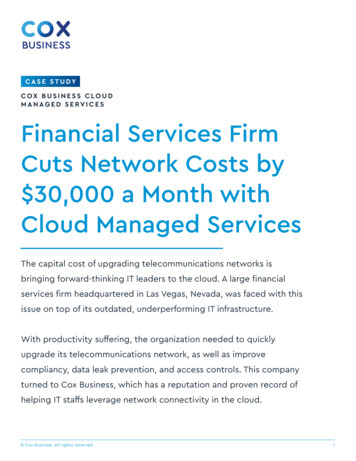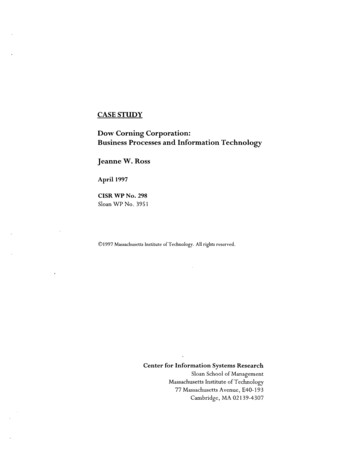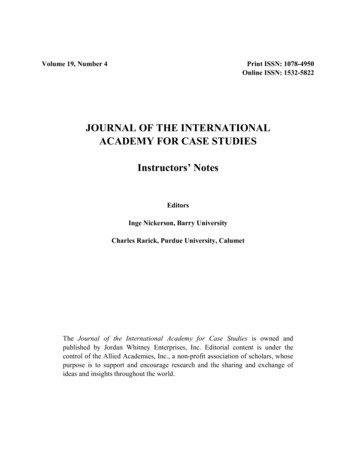
Transcription
International Business Case StudyQCFMicrosoftTuesday 5 December 2017, AfternoonThis is an open-book examination, and you may consult any previously prepared written materialor texts during the examination.Only answers that are written during the examination in the answer book supplied by theexamination centre will be marked.Notes As in real life, anomalies may be found in this Case Study. Please simply state yourassumptions where necessary when answering questions. ABE is not in a position to answerqueries on Case data. Candidates are tested on their overall understanding of the Case andits key issues, not on minor details. There are no catch questions or hidden agendas. Your answers should be based on the case study content and on your general knowledge ofmarkets. Any subsequent events impacting on featured organisations, their competitors andtheir markets should be ignored. Do not make contact with any of the featured organisations in order to obtain moreinformation. The information included in the Case Study will be sufficient to answer thequestions in the Question Paper.6IBCS12171
December 2017 International Business Case StudyMicrosoftTable of ContentsINDUSTRY ANALYSIS . 3COMPANY OVERVIEW . 4FINANCIAL PERFORMANCE . 5Segment Reports . 5Productivity and Business Processes . 5Intelligent Cloud . 6More Personal Computing . 6SWOT ANALYSIS . 8COMPETITION . 9Apple . 9Google (Alphabet Inc) . 10IBM . 10SAP . 10PRODUCT WARS . 11ORGANISATIONAL STRUCTURE AND CULTURE . 15CORPORATE SOCIAL RESPONSIBILITY . 16Appendices . 21Appendix 1: Microsoft Segment Data from Microsoft’s 2016 Annual Report . 21Appendix 2: Microsoft detailed SWOT Analysis by Research Methodology (2017) . 22Appendix 3: Microsoft Business Organization: Extract from Annual Report . 26Appendix 4: Article from TechCrunch, 2 July 2017 . 28Appendix 5: Article from The Washington Post, 25 July 2017 . 296IBCS12172
INDUSTRY ANALYSISThe technology sector can be somewhat confusing to categorise. According to Investopedia (2017), thetechnology sector is the category of stocks relating to the research, development and/or distribution oftechnologically based goods and services. This sector contains businesses revolving around themanufacturing of electronics, creation of software, computers or products and services relating toinformation technology.The technology sector offers a wide range of products and services for both customers and otherbusinesses. Consumer goods like personal computers, stereos and televisions are continually improvedand upgraded, offering the latest technology to all users. Businesses receive information and servicesfrom software and database systems, which allow the companies to make strategic business decisions.In another article, Investopedia (2017a) breaks down the ‘tech industry’ into a few categories which rangefrom personal computers to entertainment media to mobile payment systems. These can also be groupedas: Personal computers: main competitors in this space include Apple, Dell, Acer, HP, Sony, andToshiba. Mobile computers: competitors include Apple, Alphabet Inc. (GOOG), Samsung, and Nokia. Smartphones: this industry was once dominated by Canadian giant BlackBerry Limited (BBRY)(formerly Research in Motion Limited). That changed quickly with the introduction of the Apple iPhone.The iPhone has literally decimated BlackBerry’s business model and caused the company torestructure several times. Alphabet Inc.’s Google produces the Android operating system, which isinstalled on most non-Apple phones produced by Huawei, Samsung, Sony (SNE), HTC, Lenovo, andothers. Entertainment media and applications: the two major players in this space are Apple and Google,with the Apple iOS running on its iPhones and iPods, and Google Android running on most competitorphones and tablets. Each operating system interfaces with App Store and the Google Play Storerespectively, allowing users to purchase music, books, applications and other media. Mobile payments: Apple entered the mobile payment industry in 2014 but has quickly become a titanin this arena. According to CEO, Tim Cook, the company took on more than 1 million users in its first72 hours, making Apple Pay larger than ‘all competitors combined’. Key competitors in the mobilepayment industry include PayPal and Google. According to research from fin tech analysts, Apple Payhas 86 million users (as of April 2017) and is the dominant player in the mobile payment industry. Incontrast, Samsung Pay has 34 million users, and Android Pay has 24 million users.According to Microsoft (2017), the industry is dynamic and highly competitive, with frequent changes inboth technologies and business models. Each industry shift is an opportunity to conceive new products,new technologies, or new ideas that can further transform the industry. It is therefore important to pushboundaries of what is possible through a broad range of research and development activities that seek toidentify and address the changing demands of customers and users, industry trends, and competitiveforces.The market for software, devices, and cloud-based services is dynamic and highly competitive. Devicesand the form factors that customers prefer evolve rapidly, and therefore it is important for technologycompanies to evolve and adapt over an extended time in pace with this changing environment.Changes in Europe have also seen strengthening of the US dollar relative to certain foreign currenciesthroughout fiscal year 2015, and continuing into fiscal year 2016, and this has an impact on prices andunits sold.6IBCS12173
COMPANY OVERVIEWMicrosoft Corporation is an American multinational technology company, which develops and sells a widerange of consumer and enterprise software, hardware, services, and electronics. Founded by Bill Gatesand Paul Allen in Albuquerque, New Mexico, in 1975, the company is currently based in Redmond,Washington. (Statista, 2017)Microsoft’s mission is ‘to enable people and organizations throughout the world to do more and achievemore by creating technology that transforms the way people learn, work, play, and communicate’.Microsoft employs approximately 114,000 people on a full-time basis; 63,000 in the US and 51,000internationally. Its business strategy can be classified as product differentiation. The company developsadvanced technology products and services and sells them for premium prices. Moreover, Microsoftbusiness strategy is currently focused on ‘cloud-first, mobile-first’, growth through mergers andacquisitions, and exploring business opportunities related to augmented and virtual reality. (ResearchMethodology, 2017)Long seen as one of the world’s largest and most successful IT companies, Microsoft’s global revenuehas increased relatively consistently since its conception, with the figure standing at 85 billion in 2016.That same year, the company’s net income topped 16 billion, higher than 2015 but down from its 2011peak of 23 billion. The company’s success has translated into personal wealth for those closely involvedin its formation. Predictably, both Bill Gates and Paul Allen have both amassed large fortunes on thestrength of Microsoft’s growth. (Statista, 2017)Historically, Microsoft has generated the majority of its revenue from its commercial licensing businesssegment. This is perhaps unsurprising, considering that the segment traditionally included licensing forMicrosoft Office, the most commonly-used suite of office/productivity software, as well as Microsoft’senterprise server operating systems. Windows has been installed in more than 1 billion devices and theintroduction of Xbox Live has seen a growth to 49 million users every month, which is a 33% increasefrom last year. The growth was mainly driven by the game franchise Minecraft, which has sold over 106million copies. The company plans to drive that even more with an 18-month plan to release the Xbox OneS, Project Scorpio and investments in growth areas that include video, eSports and virtual reality.(Microsoft 2016 Annual Report)Recent changes to Microsoft’s financial reporting structure have meant that the new largest segment isMore Personal Computing. This comprises Microsoft Windows, which continues to dominate the personalcomputer operating system market, as well as Microsoft devices, such as the Surface, gaming revenuefrom consoles, and search advertising. Microsoft’s gaming consoles also continue to perform well, with theXbox One gaming console selling around six million units in 2016. (Research Methodology, 2017)In 2016, Microsoft acquired LinkedIn for 26 billion. The deal marked Microsoft’s biggest acquisition todate, well surpassing the 8.5 billion paid for Skype in 2011. In 2014, Microsoft acquired gaming softwarecompany, Mojang, for 2.5 billion. Mojang’s flagship game, Minecraft, has been one of the top-sellinggames on iOS, the iPhone operating system, and brings in significant revenue from sales, merchandising,and licensing. Since 2014, Microsoft has made a number of strategic purchases of smaller vendors,including developers of key mobile, cloud, and analytics software and platforms. (Statista, 2017)6IBCS12174
FINANCIAL PERFORMANCEAccording to Microsoft Annual Report (2016), Microsoft generated 85.3 billion in revenue, 52.5 billion ingross margin, and 20.2 billion in operating income. Revenue was 92.0 billion, with 27.9 billion inoperating income. Microsoft also recorded a shareholder return of 26.1 billion, up 12% from last fiscalyear.Table 1: Microsoft’s financial highlights( mil, except per share data)Year ended June 30,RevenueGross marginOperating incomeNet incomeDiluted earnings per shareCash dividends declared per shareCash, cash equivalents, and short-term investmentsTotal assetsLong-term obligationsStockholders’ 4(Source: Microsoft 2016 Annual Report)Segment ReportsMicrosoft uses segments for its financial reporting and these segments are split into the following:1. Productivity and Business Processes2. Intelligent Cloud3. More Personal ComputingProductivity and Business ProcessesThis segment consists of products and services in productivity, communication, and information services,spanning a variety of devices and platforms. This segment primarily comprises Office Commercial, OfficeConsumer, and Dynamics business solutions.Office Commercial is designed to increase personal, team, and organisational productivity through a rangeof products and services. Office 365 is a cloud-based service that provides access to Office, plus otherproductivity services. Client Access Licenses (CALs) provide access rights to certain Office Commercialproducts and services, including Exchange, SharePoint, and Skype for Business, and revenue is reportedalong with the associated Office products and services.Office Consumer is designed to increase personal productivity through a range of products and servicesthat include Skype, Outlook.com, and OneDrive. These are largely driven by subscriptions, advertising,and the sale of minutes. Dynamics provides business solutions for financial management, customerrelationship management (CRM), supply chain management, and analytics applications for small and midsize businesses, large organisations, and divisions of global enterprises. Dynamics revenue is largelydriven by the number o
Appendix 2: Microsoft detailed SWOT Analysis by Research Methodology (2017). 22 Appendix 3: Microsoft Business Organization: Extract from Annual Report . 26 Appendix 4: Article from TechCrunch, 2 July 2017 . 28 Appendix 5: Article from The Washington Post, 25 July 2017 . 29. 6IBCS1217 3 INDUSTRY ANALYSIS The technology sector can be somewhat confusing to











